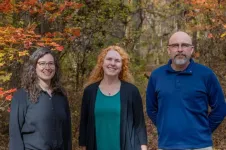(Press-News.org) Appalachia is globally recognized as a key supplier of non-timber forest products (NTFPs) with growing demand for its resources. Nearly half of the woodland medicinal species in the global nutraceutical market come from the region, contributing to a multibillion-dollar industry.
Species such as ginseng, slippery elm, and black cohosh are prominent understory sources of medicinal material. Appalachian edible products are also gaining popularity beyond the region. Ramps, a wild Appalachian plant, can sell for more than $20 per pound in places such as New York City.
Spanning 205,000 square miles, Appalachia is home to over 100 marketable species, including botanicals such as ginseng and black cohosh as well as mushrooms and valuable understory tree and shrub species used in crafts and landscaping. These species traditionally are wild harvested, but interest in cultivating them using an agroforestry practice known as forest farming is on the rise.
As demand for Appalachian NTFPs grows, forest farmed material is becoming increasingly sought after by both domestic and international consumers. John Munsell, professor in the Department of Forest Resources and Environmental Conservation in the College of Natural Resources and Environment and a Virginia Cooperative Extension specialist, received a $500,000 grant from the Appalachian Regional Commission to conduct a preliminary study on a natural economic solution for the region.
“To scale a cultivation economy, it's essential that people have access to affordable resources, and that the supply chain — from planting to processing and distribution — is well established,” Munsell said. “Formalizing forest farming businesses and developing the workforce are key to ensuring that the entire system runs efficiently. Additionally, cultural aspects like tourism and traditional knowledge should be integrated into the business planning process to create a more sustainable and comprehensive economy.”
To better understand the culture around these NTFPs, Munsell is collaborating with Shannon Bell, professor of environmental sociology in the College of Liberal Arts and Human Sciences. Bell conducted research with Appalachian wild harvesters and local buyers of medicinal roots and herbs to study the stark inequities in the woodland herbal supply chain and to develop strategies for addressing these challenges. The work’s aim is to help Central Appalachian communities retain more of the profits from the herbal industry by using forest farming techniques to help populations of native at-risk forest botanicals survive and thrive in the wild.
“Our mission is to harness the region's sustainable ‘green wealth’ – a true, culturally resonant resource — through stewardship, moving it into a competitive market without the exploitative practices often seen in extractive industries,” Munsell said. “We've spent years engaging and training woodland owners and wild-harvesting communities, helping them transition to traceable, sustainable forest farming practices. But to truly scale, we now need to invest in processing facilities, attract companies to the region, and formalize businesses that can fully utilize cultivated raw materials, from medicinal plants like ginseng and black cohosh to culinary and decorative products.”
The effort is complex and Munsell assembled a broad partnership of 11 Appalachian universities and nonprofit organizations to address specific facets of the value chain. For example, workforce development is essential, as skilled labor is needed for processing, chemical testing, and maintaining high-quality standards, while tourism can offer an experiential way to highlight these efforts and the Appalachian region's cultural heritage. Munsell and Katie Trozzo, program associate in the Department of Agricultural, Leadership, and Community Education in the College of Agriculture and Life Sciences, are working together to develop and guide complementary initiatives among project partners.
This collaborative work identifies tangible and actionable opportunities for scaling forest-farmed materials in the global NTFP market. There’s a focus on quality over quantity, with companies willing to pay higher prices for superior, sustainably sourced raw and value-added material. The work is part of a broader economic development strategy emphasizing local Appalachian stewardship and control over natural resources management and production.
END
Professor receives pilot funding to conduct study to increase forest farming in Appalachia
2025-03-28
ELSE PRESS RELEASES FROM THIS DATE:
New PET radiotracer provides first look at inflammation biomarker in the human brain
2025-03-28
Reston, VA (March 28, 2025)—A novel PET imaging approach can effectively quantify a key enzyme associated with brain inflammation, according to research published in the March issue of The Journal of Nuclear Medicine. The first-in-human study, which imaged the COX-2 enzyme, offers a never-before-seen view of inflammation in the brain, opening the door for COX-2 PET imaging to be used in clinical and research settings for various brain disorders.
COX-2 is an enzyme in the brain that can be markedly upregulated by inflammatory stimuli and neuroexcitation. Researchers say that the density of COX-2 in the brain may be a biomarker and effect of inflammation, ...
Genes may influence our enjoyment of music
2025-03-28
Music is central to human emotion and culture. Does our ability to enjoy music have a biological basis? A genetic twin study, published in Nature Communications, shows that music enjoyment is partly heritable. An international team led by scientists from the Max Planck Institute for Psycholinguistics in Nijmegen, the Netherlands, uncovered genetic factors that influence the degree of music enjoyment, which were partly distinct from genes influencing general enjoyment of rewarding experiences or musical ability.
Music plays an important role in human emotion, social bonding, and cultural expression. As Darwin already noted, music "must ...
Global patterns in seed plant distribution over millions of years
2025-03-28
Why do some plants thrive in specific regions but not in others? A study led by researchers at the University of Göttingen explores the factors shaping plant distributions and how these patterns have changed over millions of years. Analyzing nearly 270,000 seed plant species worldwide, the research highlights the roles of environmental conditions and dispersal barriers in influencing global plant diversity. The results were published in Nature Ecology & Evolution.
Using advanced methods that integrate plant distributions with phylogenetic information – meaning data about the evolutionary relationships among plant species – researchers ...
Fatty acids promote immune suppression and therapy resistance in triple negative breast cancer
2025-03-28
HOUSTON – (March 28, 2025) – A new study published in the journal Immunity reveals a mechanism that allows triple negative breast cancer (TNBC) to develop resistance to therapy. Researchers at Baylor College of Medicine showed that lipid accumulation in tumor cells and nearby immune cells promotes immune suppression, but disrupting lipid formulation reverses treatment resistance and the immunosuppressive microenvironment.
Standard-of-care treatment for TNBC includes chemotherapy and immunotherapy. However, some initially responsive tumors still develop recurrences. Researchers studied mouse models and found that TNBC cells that survived treatment accumulated ...
Intermittent fasting increases sex drive in male mice: an approach for low libido in humans?
2025-03-28
Long-term fasting in 24-hour cycles increases the sex drive of male mice by lowering the concentration of the neurotransmitter serotonin in the brain. This effect is linked to a diet-induced deficiency of the precursor substance tryptophan – an amino acid that must be obtained through food. Researchers from DZNE report on this in the journal Cell Metabolism, together with a Chinese team from Qingdao University and the University of Health and Rehabilitation Sciences. They suggest that similar mechanisms may exist in humans and view fasting as a potential approach for treating unwanted loss of sexual desire.
Fasting ...
Scientists create protein ‘seeds’ that trigger key pathological features of ALS and frontotemporal dementia
2025-03-28
28 March 2024, Leuven, Belgium — Accumulation of a protein called TDP-43 is a key feature of ALS and frontotemporal dementia. In a newly published study, researchers report ‘seeding’ this accumulation through fragments of the culprit protein created in the lab. The findings provide further evidence for a prion-like paradigm wherein protein aggregation occurs in a templated fashion. This breakthrough provides the research field with a powerful way to model and study the mechanisms driving neurodegeneration.
TAR DNA-binding ...
Discrimination-related depression, anxiety pronounced among multiracial, White, Asian populations
2025-03-28
EMBARGOED UNTIL 11 a.m. EST on Friday, March 28, 2025
Contact:
Jillian McKoy, jpmckoy@bu.edu
Michael Saunders, msaunder@bu.edu
##
Discrimination-related Depression, Anxiety Pronounced Among Multiracial, White, Asian Populations
A new study found that more than half of US adults encounter some form of discrimination, and that this mistreatment may fuel higher chances of depression and/or anxiety among specific racial and ethnic groups due to cultural, social, and systemic factors.
A ...
New approach makes one type of clean fuel production 66% more efficient
2025-03-28
COLUMBUS, Ohio – Researchers have uncovered a more efficient way to turn carbon dioxide into methanol, a type of alcohol that can serve as a cleaner alternative fuel.
In the lab, synthesizing methanol can be extremely difficult, due to the extremely complex reaction pathway needed to select for it. Previous attempts by the same team to manufacture this valuable liquid fuel from carbon dioxide have used a combination of cobalt phthalocyanine (CoPc) molecules and electricity, but this method is inefficient as only about 30% of the carbon dioxide is converted to methanol.
To ...
AI meets oncology: New model personalizes bladder cancer treatment
2025-03-28
Leveraging the power of AI and machine learning technologies, researchers at Weill Cornell Medicine developed a more effective model for predicting how patients with muscle-invasive bladder cancer will respond to chemotherapy. The model harnesses whole-slide tumor imaging data and gene expression analyses in a way that outperforms previous models using a single data type.
The study, published March 22 in npj Digital Medicine, identifies key genes and tumor characteristics that may determine treatment success. The ability to accurately anticipate ...
New approach could treat anthrax beyond the “point of no return”
2025-03-28
Anthrax, an infectious disease caused by the bacterium Bacillus anthracis, is often treatable in its early stages. But once the disease has progressed beyond the “point of no return” after just a few days, patients are almost certainly doomed.
In a new Nature Microbiology study, University of Pittsburgh researchers show that a cocktail of growth factors reversed would-be lethal cell damage in mice with anthrax, suggesting that this approach could be adapted for use in patients beyond the brink.
“While only a few people die from anthrax in the United States each year, there is always the concern ...




